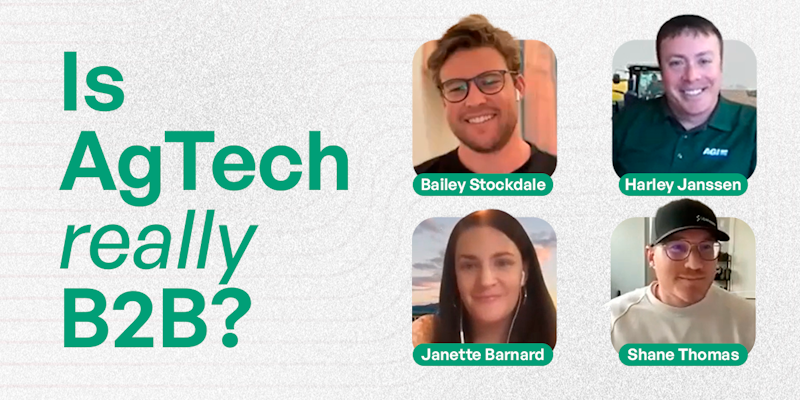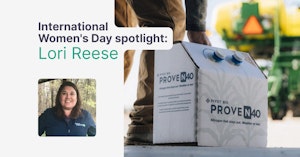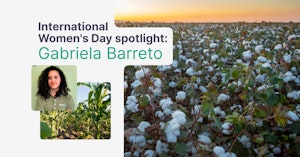"What makes Agtech so different from other tech companies or B2B SaaS startups?"
The question –or rather, the debate– is one that’s been hashed out in various meeting rooms by plenty of Agtech commercial leaders over the past decade.
Slow adoption rates, distribution issues, and churn are just a few of the topics that float to the top when the discussion pivots to the general theme of ‘what makes agriculture special.’
Leaf turned to top industry thinkers and creators to dive into the question: ‘Is Agtech really just B2B?’
Our fireside chat was led by Leaf Co-Founder and CEO Bailey Stockdale and included:
- Janette Barnard: Ruminants Lead, Merck Animal Health Ventures & Creator, Prime Future
- Shane Thomas: Founder, Upstream Ag Insights & Upstream Ag Ventures
- Harley Janssen: Vice President of Customer Success, Product and Engineering, AGI Digital
Here's a few of the top clips and takeaways from the discussion:
Janette discusses how broad the agriculture industry is and breaks down how both the product and price point can really drive what the buying process will look like.
Distribution can mean multiple things in agriculture. Janette deciphers the three different types of distribution and what they look like in agriculture.
When it comes to doing distribution well, there are a lot of potential challenges facing companies as they go-to-market. Shane dives into those complexities, specifically as they relate to a direct-to-farmer strategy.
Shane shares a story about his time as an agronomist and working with a farmer who was making a decision about fungicide on flax. His story details the nuances behind selling to individual producers and that variables such as personal dynamics, onboarding, or learning curves can influence the sales process.
Harley expands on Shane’s story and shares how the nuances behind farm-level decision making isn’t always as simple as creating a value stream map or identifying a current state versus future state scenario.
Customers don’t always equal users and that can often come into play as you think about a farm enterprise. Harley shares the example how a sales process will typically include bringing in a farm’s team of advisors (ag retailer, banker, etc.) that will influence decisions.
Farm sizes, crops, data usage, and more can vary greatly depending on geography, equipment, land usage, and more. Shane notes that all of these factors are critical as companies try to generate scalable go-to-market motions across customer segments and personas.
Companies in agriculture will often get ‘googly-eyed’ when they look at the market and read 15.1 billion bushels of corn. But as Harley points out, that oversimplification of a total addressable market can lead to complications as value propositions and messaging don’t align with various regions.
Janette points out that regardless of how you think about B2B vs. B2C vs. some hybrid, what might matter more is determining if you’ll reach that customer directly. Whether through a channel, online, or some other avenue, those tactics will ultimately guide how you sell to and service your customers.
From early adopters, to middle majority, to laggards, Janette explains that any company should have the expectation that every market –not just agriculture– will play out that way to some extent. Because of this, it’s important to not approach a go-to-market plan with a this ‘or’ that strategy, but knowing it might take a this ‘and’ that strategy to be successful.
Understanding that sometimes the best way to sell to a customer isn’t the most efficient for the business can be tough. But like Janette shares, getting the objectives and priorities right for your plan as you think about different segments is your best bet to getting traction.
A farmer always faces more risk in adopting a new technology versus non-adoption. Shane breaks down how that barrier plays out between a producer and a grain origination company and why it creates more complexity for companies to think about as they create new products.
If you’re trying to create something for all corn farmers, you might be creating something for no corn farmers. Harley explains how that truth can make it difficult for leaders to align a business plan and a strategy, while also making them question their total addressable market.
Shane closes out the panel asking a fundamental question: is the industry and the companies within it doing enough to understand who their customers are and how to go-to-market to sell to them?
Want to hear the full discussion? Watch the entire fireside chat with Janette, Shane, Harley & Bailey for more insights.
It's an exciting time to build.
Leaf's mission is to help companies build the future of agriculture by providing intuitive, powerful tools so that developers can focus on their core applications and deliver value to their customers.
Leaf's unified API helps Agtech companies become instantly compatible with all major agriculture data sources so they can focus their full effort on building valuable applications for their customers while Leaf’s team manages the complicated and time-consuming challenges of data integration, file translation, standardization, and ongoing integration maintenance.



